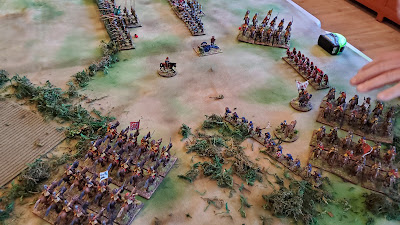Well, got to finally get the ECW figures on the table today thanks to four of my buddies coming over to play out a Marston Moor scenario. Although I am familiar with the Black Powder/Hail Caesar style of play which the Pike and Shotte rules are based upon, wasn't exactly sure how it would play out with the specific rules. All in all, it was a really fun game had by all. The one thing we felt should be changed in the future would be to lessen the amount of rough terrain which slowed down the Parliamentarian-Scots Covenanter advance. I had tried to replicate the terrain from what I read in the Osprey book as well other sources, but agreed that less of the rough would've made the game play better. Anyway, here are some of the images from the game - with captions as best as I can recollect.
The Parliamentarian-Scots Covenanters were allowed to go first as this reflects them charging into the unprepared Royalist the evening of the actual battle. Top of turn 2 with part of the Royalist foot having successfully made it up to the hedge and ditch.The Parliamentarian horse on their right wing led by Sir Thomas Fairfax being met by dismounted dragoons and cavalry led by Lord Goring.
On the Parliamentarian left Cromwell and his Ironsides charge into Royalist cavalry led by Prince Rupert. The Royalist cavalry, less their cuirassiers, had the Galloper rules which increased their basic movement to 12" from the usual 9". Also, units which were joined by Prince Rupert had the Ferocious Charge rule which allowed them to re-roll missed attacks in every round of combat when they charge or counter-charge. This was used to good effect in the game. In fact, the cavalry action was continuous for the 5 turns we played. Not the least due to the Galloper rule of them having to countercharge if able to always have to make sweeping advances.
View from the center of the battle; Newcastle's Whitecoats in center facing Scots Covenanters. One thing the players learned midway through the game was to remember that the foot regiments were made up of 3 separate units: 1 pike and two shot, and that they don't have to stay in rigid line. Soon the players got the hang of this and would use the shot more effectively, and while staying within 6" of the pike unit could always attempt to form hedgehog formation if needed.
The Royalist right. Most of the foot regiments had a light or medium cannon attached to them which allowed fire support to be manhandled along with them. The large areas of rough hindered the advance of the allied army. Although later in the game, once the players realized they could move units around terrain in smaller individual units, it became less of an issue.
Bottom of Turn 2 with Fairfax leading his cavalry through the openings in the rough areas. Goring's Royalist cavalry preparing to charge into their flank.
Turn 3 with foot regiments in the center closing in for musket fire.
A view of the Allied foot battle line. Behind them, on Cromwell's Plump are their heavy artillery.
Prince Rupert's cavaliers charging into the flank of a unit of Parliamentarian musketeers.
The Royalist left with some of their foot forming hedgehog - one unit of musketeers, while another staying in battle line for more firepower. The redcoat foot is a unit of commanded shot with firelocks.
Scots Covenanter musketeers getting into close range.
Parliamentarian foot on the right giving traversing fire upon Goring's Royalist cavalry. The troops in green are a unit of commanded shot with firelocks.
Prince Rupert and Boye in the heat of the battle on their right flank.
View of the center of the battle with Scots Covenanters closing in on Royalists.
As it was the last turn of the game, a unit of Parliamentarian cuirassiers charged into Sir Thomas Tyldesley's Regiment, even after the latter successfully formed hedgehog. The muskets failed to cause any casualties with closing fire, and the hand to hand was a draw - even with the pikes doubling their combat dice and the cuirassiers losing any charge bonus. With most of the Royalists unit holding out behind their cover and the slow advance of the allied army, we called it a close win for the Royalists.














































